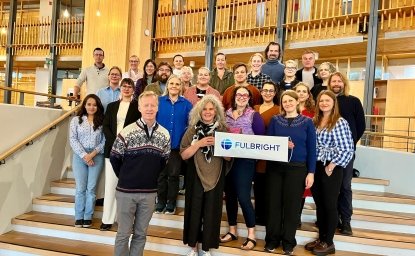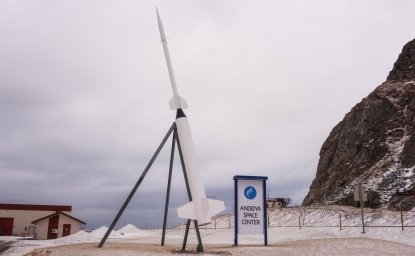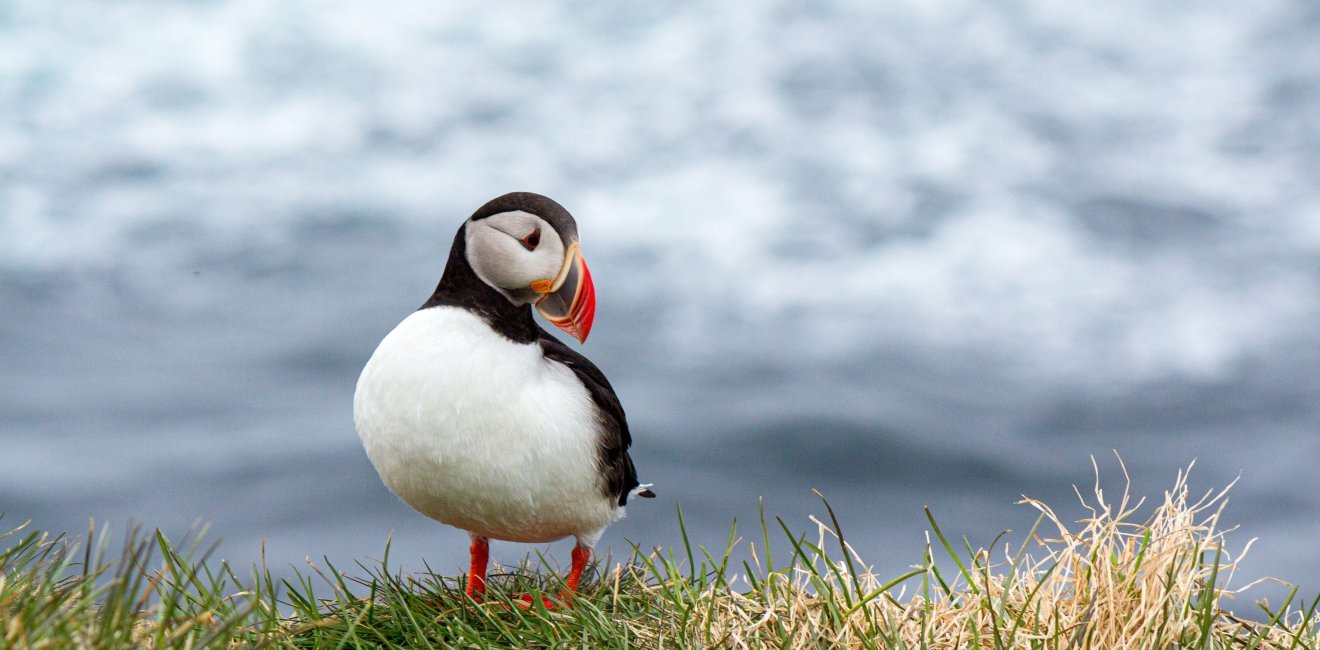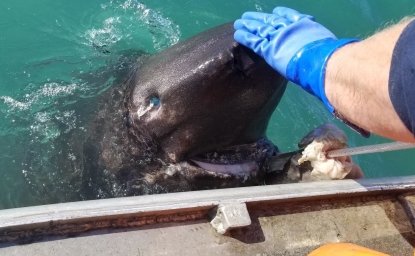
A blog of the Polar Institute
Step into the Arctic and you’ll find flora and fauna galore. Far northern waters buck and roll as polar bears hunt seals atop sea ice, whales amass krill beneath, and salmon battle up rivers to spawning grounds tucked in boreal forests hundreds of miles inland. Those forests swell with evergreens, lichens, bears, moose, and more. Beyond the treeline, the sprawling tundra hosts high-latitude icons like caribou, snowy owls, and Arctic foxes roaming among waving grasses, radiant flowers, shrubs, and mosses. Even the ice floating atop our planet is habitat for microscopic life.
The Arctic brims with biodiversity: the variety of living things. Over 21,000 species are Arctic inhabitants, including over 100 species of mammals, nearly 400 species of fish, almost 10,000 invertebrate species, and more than 2,000 species of plants. Many of these species are endemic, meaning they occur nowhere else on Earth, with narwhals, musk ox, and polar bears some of the most famous. Many others are only part-time residents. Those part-timers still depend on the seas, coasts, rivers, and lakes of the north. Birds seen in your own backyard might frequent Arctic ecosystems when they aren’t stopping at feeders further south; over 100 migratory bird species over-summer in the High North. Marine species like whales make vast journeys, too, traversing to and from the Arctic along oceanic highways hundreds to thousands of miles long.
Yet biodiversity in the Far North is increasingly imperiled. As carbon emissions rise and far-northern human activities expand, the fabric of Arctic ecosystems and the communities that rely on them continue to unravel.
The Arctic is warming many times faster than the global average as anthropogenic carbon emissions intensify climate change and ravage the Arctic environment. Diminishing sea ice eliminates habitat for seals and feeding opportunities for polar bears. Increasing rain-on-snow events—when rain freezes as a crust on top of existing snowpack—severely inhibit ungulates like reindeer, caribou, and muskox from finding food. Warming water temperatures harm salmon in rivers like the Yukon and Kuskokwim. Thawing permafrost impacts wildlife habitats while intensifying wildfires wreck forests and tundra.
As political and economic interest in the Arctic increases, rapidly expanding human activities in the Far North introduce their own perils. Resource extraction and other commercial development may harm ecosystems. In the fisheries world, bycatch is weakening salmon populations. Arctic shipping threatens species of all kinds through pollution, underwater noise, vessel strikes, and oil spills.
It’s a multi-pronged problem with numerous consequences.
Arctic biodiversity supports economic engines of local, regional, and global importance. Local economies, and especially Indigenous communities, rely heavily on the harvests of fish, marine mammals, berries, birds, and more. Fisheries in Arctic and near-Arctic waters support thousands of jobs and fill grocery stores around the world. Tourism is also growing in the Arctic, with far northern wildlife and landscapes a key draw.
Crucially, declining Arctic biodiversity threatens the cultures, livelihoods, and ways of life of Arctic residents, particularly Indigenous Peoples. Indigenous Peoples of the High North have been intrinsically tied to Arctic biodiversity for at least several thousand years, connections which still thrive today. As Arctic biodiversity dwindles and changes, however, these connections are endangered. Arctic Indigenous People are not driving these changes despite being those whose way of life are most at risk.
Yet much is being done, and efforts addressing threats to Arctic biodiversity should not be overlooked.
Individual Arctic nations are moving the needle towards safeguarding biodiversity. Area-based conservation is one powerful tool, with the Arctic National Wildlife Refuge and the re-established North Pacific Northern Bering Sea Climate Resilience Area being two important Arctic American protected areas. Internationally, Canada’s Tallurutiup Imanga National Marine Conservation Area and Tuvaijuittuq Marine Protected Areas are excellent examples. Other US domestic policies abound, from national research programs informing conservation to laws like the Marine Mammal Protection Act and Endangered Species Act. Of note are the many co-management arrangements such as the Eskimo Walrus Commission, where Indigenous communities and federal agencies collaborate to collectively manage shared natural resources.
On a broader scale, intergovernmental organizations and international treaties govern the research, harvest, and conservation of biodiversity in the Far North. Canada and the United States have collaborated on salmon management for decades, most recently through a seven-year moratorium on Yukon River chinook salmon harvests. The Arctic Council’s Conservation of Arctic Flora and Fauna Working Group has unified the biodiversity preservation efforts of the Council’s eight member states, permanent participants, and collection of observers since 1991. Most recently, the Central Arctic Ocean Fisheries Agreement’s preemptive ban on high seas Arctic Ocean fishing established a new precedent in northern policy upon its 2021 entry into force. The treaty’s novel application of the precautionary principle, mandate to incorporate Indigenous Knowledge, and inclusion of non-Arctic states and entities were all firsts for an Arctic treaty.
So, what is the path forward?
It is imperative to build on the Central Arctic Ocean Fisheries Agreement’s precedent of applying the precautionary approach to Arctic biodiversity, particularly where both Arctic and non-Arctic states’ interests are involved. This means engaging in actions which could potentially impact species if, and only if, those actions have first been proven benign. Consequences for Arctic Indigenous Peoples, whose ways of life are inseparable from the biodiversity of their homes, must be centered and better prioritized within decision making. Protecting Arctic habitats and ecosystems through area-based conservation remains an important mission and globally galvanized by the 30x30 initiative. Maintaining robust panarctic research, data sharing, and collaboration is more essential now than ever.
Protecting Arctic biodiversity is both a cultural imperative and an economic necessity. The Arctic’s unique ecosystem is unlike any other on Earth, and as one of the planet’s most rapidly changing regions, it presents a critical test of humanity’s ability to stop and reverse rapid biodiversity loss. Our commitment to implementing precautionary approaches, prioritizing Indigenous needs, and fostering international collaboration must be unwavering.
Author


Polar Institute
Since its inception in 2017, the Polar Institute has become a premier forum for discussion and policy analysis of Arctic and Antarctic issues, and is known in Washington, DC and elsewhere as the Arctic Public Square. The Institute holistically studies the central policy issues facing these regions—with an emphasis on Arctic governance, climate change, economic development, scientific research, security, and Indigenous communities—and communicates trusted analysis to policymakers and other stakeholders. Read more

Explore More in Polar Points
Browse Polar Points
Greenland’s New Governing Coalition Signals Consensus

Fulbright Arctic Initiative IV Scholar at the Polar Institute




